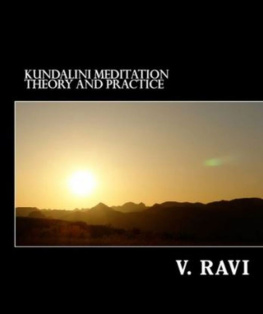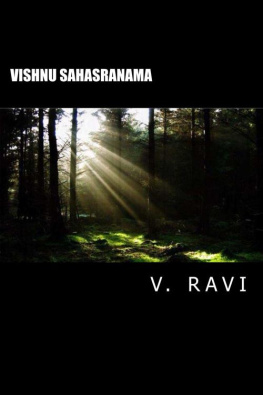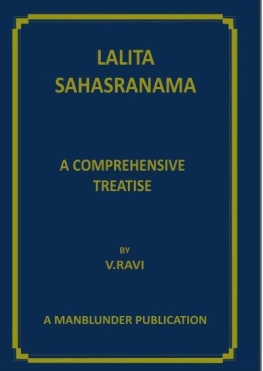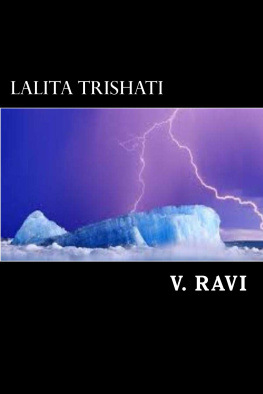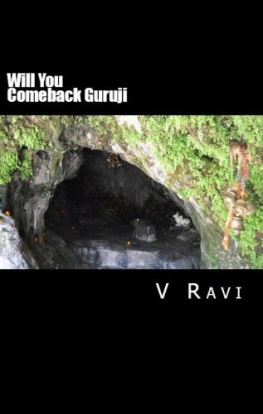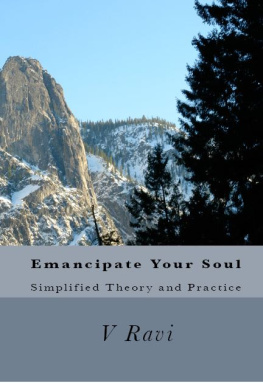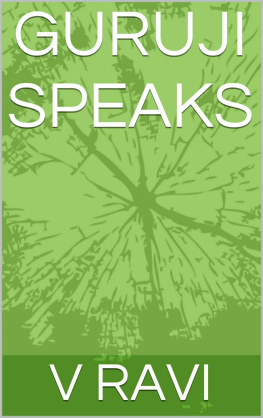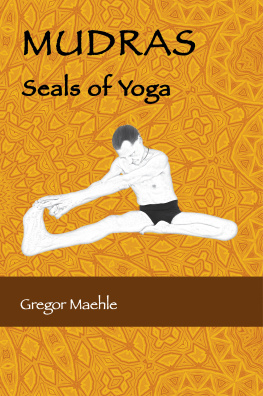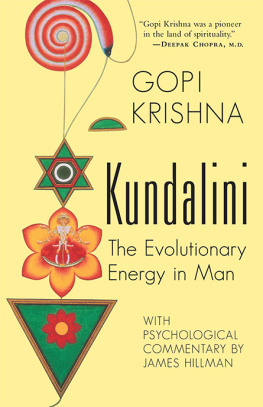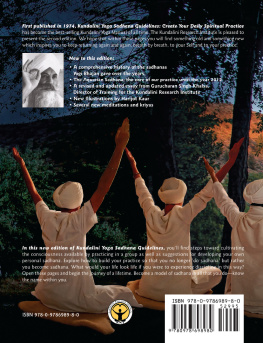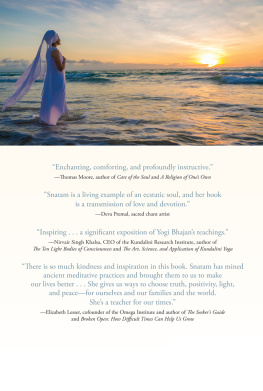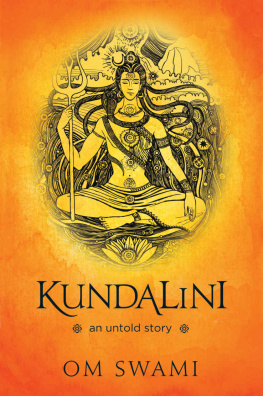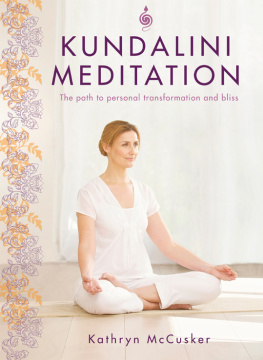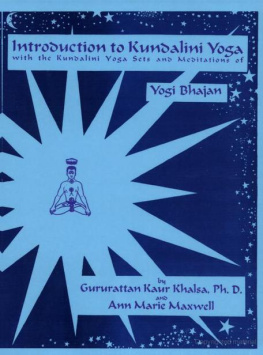V RAVI - Kundalini Meditation Theory and Practice
Here you can read online V RAVI - Kundalini Meditation Theory and Practice full text of the book (entire story) in english for free. Download pdf and epub, get meaning, cover and reviews about this ebook. year: 2013, genre: Religion. Description of the work, (preface) as well as reviews are available. Best literature library LitArk.com created for fans of good reading and offers a wide selection of genres:
Romance novel
Science fiction
Adventure
Detective
Science
History
Home and family
Prose
Art
Politics
Computer
Non-fiction
Religion
Business
Children
Humor
Choose a favorite category and find really read worthwhile books. Enjoy immersion in the world of imagination, feel the emotions of the characters or learn something new for yourself, make an fascinating discovery.
Kundalini Meditation Theory and Practice: summary, description and annotation
We offer to read an annotation, description, summary or preface (depends on what the author of the book "Kundalini Meditation Theory and Practice" wrote himself). If you haven't found the necessary information about the book — write in the comments, we will try to find it.
Kundalini Meditation Theory and Practice — read online for free the complete book (whole text) full work
Below is the text of the book, divided by pages. System saving the place of the last page read, allows you to conveniently read the book "Kundalini Meditation Theory and Practice" online for free, without having to search again every time where you left off. Put a bookmark, and you can go to the page where you finished reading at any time.
Font size:
Interval:
Bookmark:
KUNDALINI MEDITATION
THEORY AND PRACTICE
BY
V. RAVI
A MANBLUNDER PUBLICATION
CHENNAI, INDIA
www.manblunder.com
Copyright with the author
All rights reserved. No part of this book may be reproduced, stored in retrieval system or transmitted, in any form or by any means, electronic, mechanical, photocopying, recording or otherwise without the written permission from the author, except for brief passages quoted in reviews or critical articles.
PREFACE
What is Kualin? It is a difficult question to answer. Though kualin itself is the power of pra, the life sustaining force, it is typically a spiritual alchemy. Alchemy can be interpreted to mean the way two individuals relate to each other. Two individuals referred here are the Self and the self. In other words, it hastens the process of spiritual evolution and ultimate realization. There are three types of spiritual evolution. The normal type is related to external worship accompanied with rituals, where connectivity between God and the practitioner is established in stages, which is comparatively a slow process. However, this practice lays a strong foundation for a perfect spiritual path. The first transformation towards spiritual life happens during this state, where ones ego begins to get depleted. The second type is meditating on Paraktis kmakal form, which can be broadly defined as the innermost triangle of ri Cakra and the bindu within. On the grosser side, kmakal can be described as Her mantra form, but subtly this conveys much more. Kma refers to the object of adoration, the object that is desired. Here, iva becomes the most desired of all, as He is the Supreme Reality or Paramrtha. iva being the Supreme Ruler, He is addressed as Kmevara. By addressing Him thus, He not only becomes the object of desire (Kma), but also becomes the Supreme Ruler (vara). This is how He becomes Kma + vara = Kmevara. Kal refers to vimara form of iva, Mahtripurasundar. iva alone is Self-illuminating and akt illuminates the universe with the brilliance of iva. Their conjoined form is Kmakal. There are two triangles in kmakal, one upper and one lower. The lower triangle is in inverted position. Her Pacada mantra is placed on the three sides of the triangle, from where the material world originates.
Her subtlest form is Kualin. Though it is Her subtlest form, yet it is Her most potent form. Under normal circumstances, kualin is posited at the lower tip of the spine. When this energy is awakened, She begins Her journey towards top of the head, where iva awaits Her arrival and their union takes place at sahasrra, which technically, is not one among the six psychic chakras. This type of worship is also known as samaycra (established procedure or proven method, a terminology often used in Tantra Scriptures). This type of worship is considered as the most secretive worship, where no external objects, whatsoever are involved. For this type of worship only two things are needed, ones mind and ones consciousness. This is called kualin meditation. It is not simply one of the meditative techniques; it is just being with Her in the state of Bliss, during this meditation.
Other terms that are generally used to refer kualin are vital force, life energy, pra, chi (or chee), etc. But none of these terms can exactly describe kualin, because it really means only the subtle form of Parakti. There are two ways of activating kualin. One is the natural way and solely depends upon ones purity of devotion. When ones devotion to Her transforms into love for Her, kualin gets awakened automatically and depending upon ones depth of love, it activates different psychic centres (chakras). Alternatively, on Gurus initiation, aktipta (descent of Her Grace) descends on the aspirant. Guru, who is referred here should be a Self-realized person and should be capable of initiation, by working on the psychic body (energy body) of the aspirant. This Guru on initiation kindles the kualin of the aspirant and makes it active. The disciple on instructions from his Guru works on his kualin through higher level of inner contemplation, takes Her upwards till jcakra, which is the chakra (the word chakra is used both as cakra and chakra; the former is in IAST font) of the Guru. Only in this chakra, the disciple receives his Gurus commands, even from a distance. Mantras are imparted by a Guru through this chakra, which is considered as the best of initiation. But it is important that Guru should have the ability to initiate this way.
V ijnabhairava Tantra (verse 67) speaks about Kualin. By closing the sensory organs, pra begins to ascend through the central canal of the spinal cord and this can be realized through tingling sensations at different chakras in the spinal cord. At the time of feeling the tingling sensation, one can realize Bhairava. Pra is used for all actions of the body. For example, for seeing, hearing, walking, etc pra is required. If the organs of perceptions are closed, there is no work for pra. Pra cannot remain idly. Since there is no work for pra, it begins to ascend through suumna (spinal cord) from mldhra to brahmarandhra at sahasrra. Brahmarandhra is an orifice at the top of the head in sahasrra, through which gross body draws pra from the cosmos. Therefore, a proper kualin meditation needs an appropriate control of sensory organs. For example, while practicing kualin yoga, there should be no distractions whatsoever, as this could cause panic attack in the practitioner. Thus, it is clear, that capacity to control and modify pra is the most important factor in kualin activation. iva tells His Consort Bhairavi (Vijnabhairava Tantra verse 154 till the end), Inhalation and exhalation happen on its own, thereby awakening the Kualin energy, which goes up the spine and She (Parakti) is to be worshiped in suumna, the central canal of the spinal cord. This is true ketra (pilgrimage centre). She is the experience that happens in the mind and She is also beyond human experience (immanent and transcendent). Dualism gradually gets dissolved along with the gaining of potency by Kualin. It is like the growth of a girl to womanhood. Kualin does not become potent in the initial stages, but attains potency over a period of time. The increase in potency is directly related to the depth of contemplation, nature of life, food habits and above all practice. The one, who perpetually stays connected with Parakti, the Goddess Kualin (Parakti and Goddess Kualin are the same) enters the state of supreme bliss, and in this state he attains Bhairava. iva can never be attained directly. It is only through Parakti, the Supreme iva can be attained. Once iva is attained, there is nothing left for him and he is never born again. The knowledge about iva is sovereign in nature and none can impart that knowledge except Parakti and thus, She becomes his Guru. In reality there is nothing in that Supreme Knowledge and this is known as void. When one becomes iva due to realization, he does nothing and becomes like a moving object, unconcerned and unattached with the material world. In a day (day and night consisting of 24 hours), a person inhales and exhales 21,600 times and this is the true mantra ( ha at the time inhalation and sa at the time of exhalation. The continuous concentration on these subtle sounds gives rise to the inherent mantra soham and this is known as a-japa, which means no japa. When the japa is happening inwardly and perpetually, where is the necessity of other mantra japas? 21600 breaths are meant for normal human beings. If one attempts to reduce this number by slow breathing and by holding the breath both internally and externally it not only increases the life span, but also helps in concentration during meditative sessions.
O! My dear Bhairavi! The Supreme Goddess! I have explained to you (upper case y is not used because She is now addressed by iva) the most precious and sacred teaching which leads to immortal state (liberation) and this should not be revealed to someone who is not worthy of this sacred teaching. This should be taught only through a Guru (not guru). One should learn from this teaching that all material things are impermanent and this sacred and secretive knowledge alone is permanent. One can even choose to die but the quest for final liberation should never be given up.
Next pageFont size:
Interval:
Bookmark:
Similar books «Kundalini Meditation Theory and Practice»
Look at similar books to Kundalini Meditation Theory and Practice. We have selected literature similar in name and meaning in the hope of providing readers with more options to find new, interesting, not yet read works.
Discussion, reviews of the book Kundalini Meditation Theory and Practice and just readers' own opinions. Leave your comments, write what you think about the work, its meaning or the main characters. Specify what exactly you liked and what you didn't like, and why you think so.

